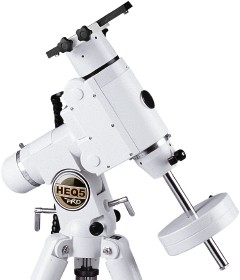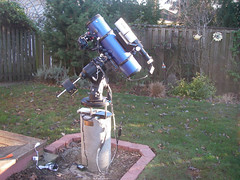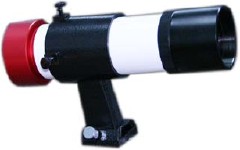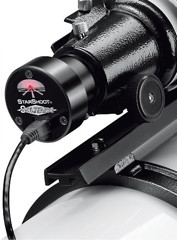On standalone autoguiders
It’s a good thing I haven’t gotten around to buying an autoguider yet, because there have been a number of recent developments in that area that might influence what I end up buying.
I’ve mentioned autoguiders before, but I suppose I should back up and explain to some of you just what an autoguider is.
The short version is it’s a small digital camera that compensates for tracking errors made by a telescope mount that would lead to blurry or trailed star images in long-exposure astrophotography.
If that’s still a lot to swallow, here’s the long version, which may make you go all glassy-eyed. (This is very nerdy.)
 Astrophotography requires long exposures and lots of magnification to create those awesome photos. Because the Earth rotates, a stationary camera can’t capture more a few seconds to a fraction of a second, depending on the magnification, without star trails forming. So any telescope a camera is attached to has to be attached to a motorized or computerized equatorial mount that slowly turns to match the Earth’s rotation.
Astrophotography requires long exposures and lots of magnification to create those awesome photos. Because the Earth rotates, a stationary camera can’t capture more a few seconds to a fraction of a second, depending on the magnification, without star trails forming. So any telescope a camera is attached to has to be attached to a motorized or computerized equatorial mount that slowly turns to match the Earth’s rotation.
But the mount isn’t perfect. Any mount, particularly one that mere mortals can afford, will have errors in the gear mechanism that will turn up in an exposure (as little jiggles) any longer than, say, a minute or two. And to avoid stars from drifting across the exposure, creating little star trails, the mount has to be precisely polar aligned. Which someone like me has to do, usually by hand. What would be a pretty good polar alignment for visual uses, or for a wide field of view, might be catastrophically useless for astrophotography, particularly at high magnifications.
One way to deal with these issues was to install a small telescope alongside or on top of the main telescope-and-camera. This was called a guidescope. Astrophotographers would centre their guidescopes on a star in the scope’s field of view, called a guide star, and while they were taking pictures through the main scope, they would watch their guide star through the guide scope; if it drifted, they would adjust the mount — push some buttons, twist some knobs — to put the guide star back in the centre of the guidescope’s field of view.
 Just imagine how much fun guiding must have been after a few hours of it.
Just imagine how much fun guiding must have been after a few hours of it.
Fortunately, it’s been automated. Enter the autoguider, which replaced the astrophotographer’s watchful eye with a small digital camera. That guide camera plugs into two things: control hardware (nowadays usually a laptop running PHD Guiding or some other application) and the computerized telescope mount itself, many of which now have autoguider ports. The autoguider detects when the guide star starts to drift, and sends a command to the mount to pulse the motors until it’s back where it’s supposed to be.
Sounds handy, doesn’t it?
Now autoguiding requires an awful lot of gear. You need a separate guidescope (or an off-axis guider, which allows you to guide from the main telescope, but you can’t do that with every telescope). You need something to attach the guidescope to the main telescope — guide rings. You need to make sure that your telescope mount has an autoguider port (sometimes called an ST4 port, after SBIG’s early standalone autoguider). You need the autoguider camera itself (you can use other astronomy cameras as autoguiders, but you’ll need an adapter). And most of the time you need to have a computer to control the autoguider from.
 I’ve been trying to think of ways of simplifying the gear requirements. I had been thinking about KW Telescope’s KWIQ Guider, which attaches the guider to a 50mm finderscope. That would be smaller and lighter than having to use a separate guidescope plus rings. Besides, the telescope I mainly want to take pictures through, my 80mm apo refractor, can’t have guidescope rings attached to it, so I’d have to do something more complicated to mount a guidescope (probably beside it, using a transverse mounting plate).
I’ve been trying to think of ways of simplifying the gear requirements. I had been thinking about KW Telescope’s KWIQ Guider, which attaches the guider to a 50mm finderscope. That would be smaller and lighter than having to use a separate guidescope plus rings. Besides, the telescope I mainly want to take pictures through, my 80mm apo refractor, can’t have guidescope rings attached to it, so I’d have to do something more complicated to mount a guidescope (probably beside it, using a transverse mounting plate).
But I’d still have to use a laptop — moreover, I’d have to use a Windows laptop, because while PHD Guiding is Mac-compatible, most camera drivers aren’t. I’d given some thought to using a netbook, to installing Windows on my MacBook Pro, or to using a profoundly ancient Windows laptop, but all in all I’d rather not have to use a laptop at all — it’s one more damn thing to have to haul into the field, one more damn thing that needs power, one more damn thing subject to the elements. If I was using a dedicated astronomical camera I’d need one, no question, because those cameras are all operated by computer — but I’ll be shooting with a digital SLR for the foreseeable future.
One recent development has been the return of the standalone autoguider — one that comes with its own handheld controller and doesn’t need to be connected to a computer to function. This is a godsend for digital SLR astrophotographers, who can now leave their computers behind.
 The Italian company LVI makes one called the SmartGuider. Orion has rebranded it as the Orion StarShoot Solitaire and sells it for $500. LVI has also made a successor that adds camera and focuser control called the SmartGuider 2; I believe that this is the model that the Canadian telescope store Perceptor sells for $630.
The Italian company LVI makes one called the SmartGuider. Orion has rebranded it as the Orion StarShoot Solitaire and sells it for $500. LVI has also made a successor that adds camera and focuser control called the SmartGuider 2; I believe that this is the model that the Canadian telescope store Perceptor sells for $630.
Compared to autoguiders that use a computer, standalone autoguiders are more expensive: Orion’s regular autoguider, for example, only costs $280, and is sold in a package that includes scope and rings for $420; the KWIQ Guider package costs $400. That’s about to change, because Celestron has just announced its own standalone autoguider, which is due to ship in September. Via Twitter, Celestron told me that it will sell for only $300. That’s a lot lower than the competition.
In a related development, a KW Telescope ad in the current issue of SkyNews said that they were selling a mounting package for owners of standalone autoguiders — essentially, their KWIQ Guider without the guide camera — for $189. (It’s not on their website yet.) So in theory I should be able to have my cake and eat it to: a standalone autoguider using a small guidescope package. (Though the Celestron autoguider’s manual recommends at least 80mm of aperture, so a 50mm finderscope may not be sufficient.)
But at least as far as I’m concerned, purchasing any of this stuff is in abeyance until I can get more observing done, along with some unguided, short-exposure imaging to see what I can and can’t get away with without an autoguider.
(Photo of telescope setup by Duncan Kitchin. Used under a Creative Commons Licence.)
Previously: Gearing up for astrophotography.